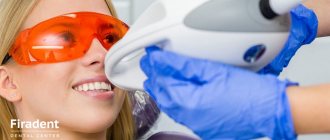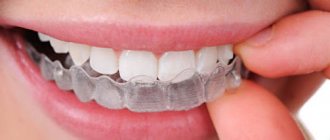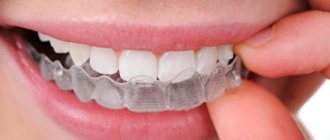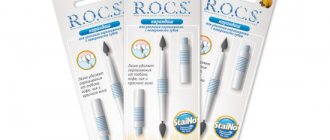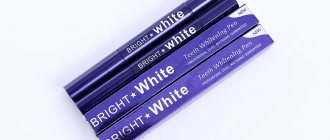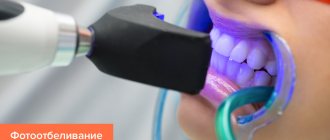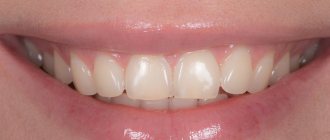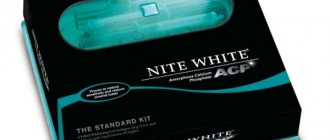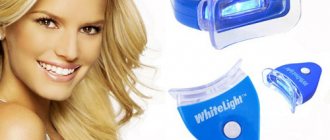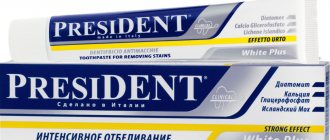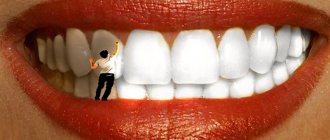Modern professional products now allow whitening by 1-2 shades, and sometimes by more than 10 shades. Teeth whitening White Perfect is one of the TOP systems.
It is recommended to whiten teeth before prosthetics or installation or replacement of fillings. Before whitening, it is required that the mouth be sanitized, dental deposits in the form of plaque and tartar removed, and inflammation of the gums relieved.
Contraindications to bleaching:
- periodontal inflammation;
- childhood;
- allergy.
Smoking is considered a relative contraindication. Restrictions on use: unsatisfactory hygienic condition of the oral cavity, pregnancy, individual intolerance.
Indications and contraindications for teeth whitening
Professional teeth whitening is the lightening of tooth enamel by one or two or more shades. It can be carried out either in a specialized dental clinic or at home.
Indications for lightening are as follows:
- stable dark color of the tooth surface;
- formation of colored stains from coffee, wine, tea and other food products that are not removed during the cleaning process.
Main contraindications:
- pregnancy and breastfeeding;
- increased sensitivity to thermal, chemical, mechanical irritants;
- severe abrasion due to various reasons;
- presence of wedge-shaped defects;
- the appearance of numerous enamel cracks;
- diagnosis of caries with unfilled carious cavities;
- a large number of fillings that are not affected by whitening agents.
If there are single fillings after completion of whitening, they must be replaced by selecting the appropriate shade.
Another question that patients ask is whether professional teeth whitening is harmful. If it is carried out by an experienced specialist, strictly adhering to all prescribed recommendations, then the procedure will not cause any visible harm to health. You should not overuse lightening, repeat it too often, using aggressive pastes in between, otherwise there is a danger of thinning the enamel. And this, in turn, leads to the destruction of dental crowns. Read more about the dangers of whitening for tooth enamel »
The best teeth whitening system according to professionals
In terms of influence on a person’s attractiveness, hardly anything else can compare with a beautiful smile. A beautiful smile means, first of all, white teeth. However, white teeth do not mean healthy. Therefore, let’s try to figure out how to whiten teeth without harming their health, and which whitening system is better?
History knows that people have always been looking for a means to whiten their teeth.
The practice of teeth whitening dates back more than two thousand years. To obtain a more effective result, healers of the Slavic peoples, before bleaching, polished the surface layer of enamel with a metal file, after which they used a weak solution of nitric acid.
This technique was used until the end of the 18th century. Interest in issues of smile and dental aesthetics became especially evident at the beginning of the 19th century.
The most effective method of teeth whitening was the active element in which was chlorine, obtained from a solution of calcium hydrochloride and acetic acid.
I think it is obvious to everyone that such whitening methods caused irreparable damage to the teeth. But, as they say, “beauty requires sacrifice.”
Fortunately, in the modern world you can achieve beautiful teeth without damaging them.
Already by 1910, all teeth whitening techniques involved the use of hydrogen peroxide along with a heated instrument or light exposure. And in 1918, the principle of activating bleaching using thermal radiation was discovered.
High-intensity light radiation causes a rapid rise in temperature in the hydrogen peroxide solution, which leads to a rapid acceleration of the chemical processes of bleaching. This principle has been improved in many ways, but it still underlies modern teeth whitening systems.
In the 21st century, we can safely say that safe teeth whitening exists, but we will return to this later.
There are the following types of teeth whitening::
- home (carried out independently at home);
- office (clinical, performed by a dentist in a clinic)
In terms of the principle of action, home and office whitening are no different.
Whitening occurs by exposing the pigment inside the tooth to a whitening gel, usually containing hydrogen peroxide or carbamide peroxide.
Hydrogen peroxide and carbamide peroxide act as powerful oxidizing agents, breaking down into water, oxygen and free radicals (atomic oxygen). Hydrogen peroxide releases most of the reactive oxygen species within 30-60 minutes after use. Carbamide peroxide releases about 50% of the active substances in the first 2-4 hours, and the remaining 50% over the next 2-6 hours. The decomposition time is the main difference between these two substances.
The free radicals released affect the tooth pigment found in dentin. It has a yellow or gray color due to double carbon bonds. The pigment transfers this color to the teeth.
When atomic oxygen acts on pigment molecules of hydrogen peroxide or urea, the “colored” double bonds of the pigment are replaced by “colorless” single bonds. As a result, the tooth loses its yellow tint and becomes whiter. This is the mechanism underlying all modern whitening methods.
Please note: only your own teeth are whitened. Fillings, veneers, and crowns have a completely different structure, and whitening technologies do not work on them.
Contraindications to any type of whitening
There are a number of contraindications to the whitening procedure. Such as:
- the presence of allergic reactions to hydrogen peroxide or other components of bleaching systems;
- dental diseases (caries, gingivitis, periodontitis - first they need to be eliminated);
- pathological abrasion of teeth or deep cracks in the enamel;
- oncological diseases;
- some mental illnesses;
- taking a number of drugs that increase photosensitivity (antibiotics, systemic retinoids, etc.);
- pregnancy and breastfeeding;
- age up to 18 years, due to the characteristics of physiological processes.
If you enter a request for teeth whitening in the search bar, a huge number of means and methods will be offered.
I strongly recommend not to go back to the Middle Ages and not to use powders, coal, soda, acid and everything else. Take care of your teeth, and there are other uses for traditional methods. Among the products produced, you should choose only those that are certified, tested and proven in the market.
The best way to whiten is to visit a dentist! However, to understand, let’s take a closer look at the most current and popular methods of teeth whitening.
Home teeth whitening.
There is an opinion that you can whiten your teeth yourself. However, it is important to remember that before using any whitening systems you need to consult a specialist, since only a doctor can really assess the condition of the teeth and determine whether there are contraindications to the procedure. Uncontrolled use can cause quite a lot of damage to tooth enamel.
When whitening at home, various whitening strips, pencils and trays with gel are used. But whitening gels, strips and other products that are commercially available contain a small percentage of bleaching substances and have insignificant and short-lived whitening activity. They are applied to the surface of the teeth for the recommended time, and if necessary, the procedure is repeated several times to achieve the desired result.
All these types of home whitening have one main advantage - it is simplicity and ease of use, but it should be understood that, as a rule, whitening occurs by no more than 2-3 tones. And at the same time, they have a rather big drawback - their lack of control.
The least effective among this variety are pencils and strips. Some systems use universal mouthguards. However, they are intended for people with perfectly straight teeth, and in fact there are very few of them. Additionally, if you use an all-purpose tray or whitening strip for crowded teeth or other teeth alignment problems, there is an increased chance that the peroxide will penetrate the gums and cause a burn. Therefore, when choosing a system for home teeth whitening, it is better to give preference to professional ones, i.e. those in which individual mouthguards are used.
Custom mouthguards are custom-made based on an impression of the jaw and are suitable for repeated use. They accurately follow the shape of the teeth, which creates optimal contact between the whitening gel and the tooth surface. Thanks to this, the likelihood of the gel penetrating the mucous membrane of the gums and oral cavity is reduced, which reduces the risk of gum burns. The patient uses it and low concentration whitening gel independently. The length of time you wear the aligner depends on the concentration of the bleaching agent, as well as the desired result.
The remedy is selected by the doctor based on the patient’s unique situation – natural tooth sensitivity, the presence of gum disease, the quality of hard tissues, etc.
The effect of home whitening lasts for a long time. Depending on the stability of the color, the dentist may recommend short-term maintenance courses once every six months.
Mouthguards can be worn both during the day and at night. The first signs of color change appear on the fourth or fifth day and gradually intensify towards the end of the course. The use of individual trays is the basis for the operation of full-fledged Philips Zoom home whitening systems: DayWhite and NiteWhite, as well as Opalescence PF gels.
We can talk about the harmful effects of home whitening systems if the patient violates the recommendations and indications. For example, an excessive amount of gel in a mouth guard will lead to its squeezing out when applied to the teeth: the gel will get on the gums, and, as a result, there may be a burn to the mucous membrane. Or the patient, in an effort to enhance the whitening effect, wears aligners longer than prescribed.
It is always necessary to strictly follow the recommendations. It should be remembered that patients with increased tooth sensitivity will experience a sharp increase in sensitivity during whitening. Using home whitening as a primary method only makes sense when the patient initially has light-colored teeth. In the case of yellow teeth, the effect will be minimal, almost zero.
Features of home whitening:
- home whitening takes longer - from 2 weeks to several months of regular use;
- the concentration of the gel in the case of home lightening is 2-3 times lower than during office procedures;
- home whitening involves applying the gel yourself, putting on a tray and then removing any remaining active substance, all on a regular basis.
I recommend home whitening in two cases::
- as a fixative in complex professional whitening;
- as maintenance 4-6 months after in-office whitening.
To ensure that the whitening procedure proceeds without harm to your health, I strongly advise you to resort to professional whitening methods, which are carried out under the supervision of a dentist.
What is the best teeth whitening?
According to dentists, the whitening system is evaluated according to the following criteria: safety, effectiveness and speed of implementation. In order to understand which whitening is the best, let's compare all the pros and cons of various in-office whitening techniques. If efficiency is taken as the main evaluation criterion, then in-office whitening (any of them) is superior to home whitening.
Professional (clinical) teeth whitening
All clinical teeth whitening procedures work on the same principle: whitening occurs due to a gel applied to the surface of the teeth, the main component of which is hydrogen peroxide.
There are four types of professional in-office whitening:
- chemical whitening (the doctor applies a gel to the teeth);
- Thermal photobleaching (gel is applied and it is activated by a lamp with warm light that heats it);
- Cold light photobleaching (the gel is activated by cold diode light, without heating);
- laser (gel is activated by a laser beam).
Note: activation is the process of accelerating the chemical reaction of a gel due to external influences: light, temperature, another reagent.
Chemical bleaching method.
In chemical bleaching, the gel is activated by mixing with a chemical catalyst and does not require the use of an external catalyst,
This is the simplest and most inexpensive procedure that allows you to achieve a lighter shade of teeth than was intended by nature.
the Opalescence Boost (Xtra) whitening system . This is a highly concentrated gel with 35 percent hydrogen peroxide.
The principle of operation is simple: the activated gel is applied to the teeth, washed off after a certain period of time, and the procedure is repeated, the result obtained can be called good.
Teeth are brightened by 5-10 shades in one session. Bleaching is practically harmless, since there is absolutely no risk of pulp overheating.
So what's the downside? The disadvantage is that to achieve a good result it is necessary to use a high concentration of gel and carry out a longer exposure, which contributes to drying of the teeth and an increase in the period of sensitivity after the procedure.
But there are also advantages - the absence of overheating of the teeth, availability and price. Therefore, teeth whitening with the Opalescense system still retains its position today.
Photo whitening (activation with warm light)
WhiteSpeed Professional Philips Zoom is a world-famous technology and professional teeth whitening system. This whitening system was invented in the USA. The essence of the technique is as follows: a special whitening gel is used, which is activated under the influence of ultraviolet radiation. At first, this technique had serious drawbacks. However, the system was gradually improved and became more and more secure.
Zoom3 has already boldly conquered the world, achieving the title safe and effective.
This method of whitening uses a lamp with ultraviolet radiation, which activates the whitening gel to more intensively penetrate the peroxide into the dentin and achieve a more powerful effect.
Ultraviolet light affects the whitening gel, containing up to 35% hydrogen peroxide, and activates the oxidizing agents contained in it, while the tooth surface can heat up , and accordingly, after the procedure, tooth sensitivity can increase significantly.
The advantages of this method of whitening: teeth are whitened up to 8-10 shades, the result will be obtained in one session; the procedure is practically harmless.
The disadvantages are the same as in the case of chemical whitening: the period of tooth sensitivity intensifies and increases, only in the case of zoom3 due to overheating of the teeth. This system already contains a gel to relieve this unpleasant symptom.
Availability and price advantages keep ZOOM3 strong. This whitening method is successfully performed by dentists and is in demand among patients.
However, answering the question: “the best whitening system according to professionals,” I rarely discuss these types of whitening with my patients, due to the emergence of more innovative methods.
If for some reason innovations are not available, then do not worry, the considered methods will still be better than long-term uncontrolled home whitening.
If an experienced doctor takes on the job, the result will be 100% and without negative consequences or discomfort.
Advanced technology – maximum efficiency
Photobleaching (cold light activation)
LED, or cold light, is a modern option for activating the whitening gel. LED lamps do not heat the surface of the tooth and do not dry it out. This minimizes the risk of sensitivity and significantly improves tolerability of the procedure.
It is the LED light source that is equipped with the whitening lamp of the Philipszoom4 generation system . Because it emits LED light, this system is called cold whitening. ZOOM 4 is the latest generation of photo teeth whitening with the most gentle treatment of teeth and high efficiency!
Therefore, the gel contains a reduced concentration of hydrogen peroxide (about 25%), the activity of which is triggered after exposure to light, while the efficiency is quite high, so the exposure time on the teeth is much shorter than previous systems.
The second component is alkaline, the function of which is to neutralize the resulting acid and prevent the destruction of enamel.
The final stage: treatment of teeth with Relief remineralizing gel containing amorphous calcium phosphate, which enriches the enamel with calcium, fills the dentinal tubules and saturates the hard tissues of the teeth with minerals. This gel restores enamel and reduces overall tooth sensitivity.
The entire procedure is painless and psychologically comfortable. The results of Zoom whitening are long-lasting and depend on following the recommendations. The only downside is the cost of the procedure.
Advantages:
- In one session, you can change the color of the enamel up to 8-12 shades in one procedure
- ZOOM 4 is equipped with a cold LED light source, which eliminates overheating of the deep layers of the tooth and gums;
- suitable for patients with tooth sensitivity;
- ZOOM 4 technology does not thin or damage the enamel;
- significant reduction in exposure time to the teeth and therefore the entire procedure
- the result lasts up to 3 years;
Laser whitening Dr. Smile
Laser teeth whitening is a method of professional teeth whitening, which is based on the use of a laser in combination with a special gel.
The gel contains 30% hydrogen peroxide and a catalyst for the laser beam. The gel collects the laser light and breaks down into particles that whiten tooth enamel.
It is enough to apply a laser to a tooth coated with a whitening composition for one to two minutes to achieve a good effect, even in the most difficult cases. There is an opinion that the effect of laser whitening is more pronounced due to the ability of the laser itself to break down pigments.
Another obvious advantage of the technique is a more controlled bleaching process, which significantly reduces the risk of pulp overheating and other possible complications.
Device Dr. Smile is a computerized system with integrated software for any procedure. The computer has programs for any procedure with clinical information and parameters. Therefore, this teeth whitening is safe and meets the protocol requirements.
At the final stage, the teeth are covered with a gel (to reduce sensitivity), which is also activated by a laser.
Today, we can say that laser teeth whitening is a method that does not damage tooth enamel and which gives long-term, stable results.
Among the disadvantages of laser whitening, one can only mention its high cost.
Advantages of laser whitening:
- The laser whitening procedure is indicated for people with high sensitivity, because there is no heating of the tooth tissue;
- all types of pigment formations are eliminated;
- you can lighten your teeth by 8-12 shades in one session;
- when exposed to laser, tooth enamel is not damaged;
- laser radiation has bactericidal properties;
- it is possible to carefully control the process, selecting the intensity and duration of exposure;
- reducing the time of exposure to teeth and therefore the procedure as a whole;
- the result lasts for a long time – up to 3 years.
Despite the fact that the impact parameters can be selected extremely accurately, the result is individual. If after the first session it was not possible to achieve the desired result, the procedure can be repeated. Its impeccable results last for several years. However, everything here is also quite individual. So, the effect will last for as long as possible if you adhere to a number of rules:
- you should stop eating foods with dyes (or at least limit their use);
- It is recommended to completely stop smoking;
- For daily oral hygiene, you should use professional toothpastes that provide a slight whitening effect;
- it is necessary to use high-quality toothbrushes or even replace them with a irrigator;
- It is recommended to have your teeth professionally cleaned every six months.
Your teeth will always be whiter than before the laser whitening procedure, since the color does not return to the original shade.
Effective whitening system
When choosing a teeth whitening technique, first of all, the doctor relies on medical indications and contraindications to the procedure, as well as the individual characteristics and wishes of the patient.
All professional methods allow you to achieve significant and lasting results. Our dental clinic uses the latest equipment and the best drugs for teeth whitening.
To decide on choosing a whitening method, you need to make an appointment with a doctor. After a thorough examination of your teeth and mouth, your doctor will suggest the most suitable teeth whitening plan for you and agree on the cost of treatment.
Professional teeth whitening is a safe, effective procedure.
Modern whitening systems cope perfectly with the problem of yellow teeth, allowing you to achieve a significant and long-lasting whitening effect.
The most effective are laser whitening and photo whitening with cold light. In combination with a maintenance course of home whitening using individual trays, they give excellent results.
The effectiveness and quality of modern whitening systems have been time-tested and are safe when used correctly and in consultation with a doctor.
Kinds
There are clinical (office, office) and home whitening. The first is carried out in a dental clinic by a dentist, takes about two hours, after which the teeth become snow-white. The second is done at home by the patient himself, but as prescribed by a doctor. Whitening at home takes a little longer - from 3 to 14 days. The achieved effect in both cases is not much different.
Depending on the condition of the teeth, it is possible to lighten the enamel by 10-12 shades.
Comparison chart of the best teeth whiteners
| Name | Main characteristics | Price |
| Yamaguchi Teeth Whitening Gel | The whitening gel contains 6% of the active substance - carbamide peroxide; its use can lighten the enamel by 3-5 tones. | ₽ 2 000 |
| Ivismile | Made in a lipstick form factor, tested in Switzerland, designed for sensitive teeth, does not contain hydrogen peroxide. | ₽ 679 |
| ON WHITE | The set includes an LED tray, activator gel (10 ml), whitening gel (15 ml) and adapters for mobile devices. | ₽ 2 090 |
| My Brilliant Smile | The set includes 7 caps | ₽ 500 |
| Zoom Nite White ACP | The concentration of carbamide peroxide in this case is 16%; kits with 22% and 9.5% of the active substance can also be found on sale. | ₽ 6 690 |
| Crest 3D White | A set of 40 strips - 20 for the upper teeth and 20 for the lower teeth, the whitening course lasts 20 days, and the first results of using the product can be seen already on the third day. | ₽ 3 900 |
| Global White stripes | The set includes 14 whitening strips. | ₽ 1370 |
Methods
As the name suggests, professional whitening is carried out in a clinic, under the constant supervision of a dentist or hygienist. There are several methods, which we will discuss in more detail.
Laser whitening
A fast, effective, safe and painless way to whiten enamel. Removes color stains from the surface, brightens the color by 5-7 tones. The patient's teeth are coated with a gel containing molecular oxygen and illuminated with a special diode laser. Under its influence, pigments are removed from the enamel.
Advantages of laser whitening:
- teeth remain white for a long time, up to several years;
- one procedure is enough to achieve a positive effect;
- Laser treatment strengthens tooth enamel; it becomes not only lighter, but also less sensitive to various irritants.
Gel whitening
Allows you to lighten the surface by 4-12 tones within one hour. An active gel-like substance is applied to the tooth enamel, which acts both independently and under the influence of light irradiation. The procedure usually lasts from 30 minutes to an hour. Read more about gel whitening »
Whitening with Zoom 3 lamp
A modern whitening method for business people with a constant lack of free time, lasts approximately one hour, allows you to whiten your teeth by 7-8 shades. Light-activated hydrogen peroxide gel is applied to the surface, after which they are treated with a special Zoom lamp! The procedure is completed with fluoride treatment to consolidate the result. Read more about whitening using Zoom 3 technology »
Before starting whitening, it is very important to isolate the patient’s lips and gums from exposure to aggressive drugs.
Airflow
Popular professional cleaning procedure Air Flow. It does not whiten teeth, but simply returns them to their original natural color, eliminating darkening of the enamel and food stains. Under high pressure, the enamel surface is treated with a mixture of water and abrasive powder. In this way, any dental deposits are removed; they are literally erased from the surface of the enamel, falling into the dental vacuum cleaner. The process is completely painless, is carried out without anesthesia, and lasts about 30-40 minutes.
Advantages of the Air Flow system:
- removes plaque even in the most difficult to reach places;
- brightens enamel by 3-4 tones in one session;
- prevents the occurrence of gum diseases;
- used for cleaning braces and implants.
Contraindications:
- inflammatory periodontal diseases;
- chronic bronchitis or asthma;
- allergic reaction to citrus fruits (the powder has the smell and taste of lemon).
To avoid staining of teeth, it is necessary to refrain from drinking coffee, cocoa, tea, red wine and other dyes in the first hours after the procedure.
Beyond Polus (USA)
Multifunctional system for comfortable, safe, convenient, effective whitening. Consists of a halogen whitening accelerator, built-in LEDs, low-level laser therapy. Allows you to whiten each tooth individually, or both jaws at the same time. Does not allow temperature increases and ultraviolet radiation. The duration of the procedure is about 30 minutes, the sustainability of the achieved result depends on the patient’s lifestyle, his eating habits, and the presence or absence of bad habits.
Opalescence Xtra Boost
An innovative whitening method that does not use light lamps. The method is based on a 38% solution of hydrogen peroxide in the form of a gel, which is applied to the vestibular surface of the teeth about 1 millimeter thick. The gel is removed using a dental vacuum cleaner after 15 minutes, after which it is washed with a stream of water using a vacuum suction.
It is important to protect the soft gum tissue with the OpalDam barrier.
If necessary, the procedure can be repeated, but only if there is no increased sensitivity of the teeth to external irritants. Read more about the Opalescence whitening system »
White & Perfect (Germany)
The White & Perfect system is not aggressive, does not damage tooth enamel, and does not cause side effects. A thin layer of special gel applied to the surface, under the influence of ultraviolet radiation, brightens it by several tones.
«
Benefits of White Perfect
The advantages of the system include:
- Excellent results and effectiveness of the drugs;
- High-quality, safe composition;
- Fast whitening process – 30 minutes;
- The ability to carry out the procedure 3 days in a row to achieve the desired result;
- Safety for teeth and body;
- Ease of manipulation;
- Affordable price;
- There is no need to use special expensive equipment;
- Absolutely painless procedure;
- The entire process is controlled by a dentist;
- The condition of the oral cavity organs improves;
- The result lasts for a long period of time.
Read more about the procedure in the source: https://putstom.ru/otdeleniya/otbelivanie/ofisnoe-otbelivanie-white-perfect.
Professional teeth whitening at home
With the help of your dentist, you must first select the most suitable system for self-whitening; fortunately, the market allows you to do this quite easily.
Whitening gels contain, in addition to flavoring additives, types and glycerin, 10 percent carbamide peroxide. The latter is considered the most effective and safe.
Repeated courses should be carried out as necessary.
In the presence of chronic diseases, allergic reactions, hypersensitivity, during pregnancy and breastfeeding, home whitening is strictly prohibited!
During teeth whitening, you must strictly adhere to your doctor's recommendations.
Home whitening is contraindicated in the following cases:
- tooth mobility;
- inflammatory gum diseases;
- exposure of roots;
- allergy to carbamide peroxide;
If you follow the instructions, teeth whitening at home is not harmful to the patient. Excessive use of whitening gels can lead to complete thinning of tooth enamel.
Luma White Plus (Opalescence)
A unique professional teeth whitening system at home. Consists of a special gel, a dental tray, and a light source. The gel is applied to the inner surface of the mouth guard, which is placed on the teeth and fits tightly to them. The lamp is aimed directly at the mouth guard and should shine for about 10 minutes. The maximum wearing time is 30 minutes per day. Longer or more frequent use causes damage to the enamel.
To achieve optimal results, the procedure must be repeated daily for 5-7 days.
How does whitening happen?
The manipulation is carried out in a dental clinic or office. First, the dentist examines the oral organs, assesses their condition, and determines the patient’s wishes. Dental preparation is carried out: professional hygiene, treatment of caries, gingivitis and other oral diseases.
The lightening procedure consists of the following stages:
- Elimination of dental plaque;
- Isolation of soft tissues, gums;
- Drying teeth;
- Applying a thin layer of whitening gel;
- Activation of the gel with a photopolymer lamp and catalyst;
- Removing drug residues;
- Evaluation of the result;
- Repeat the procedure if necessary;
- Recommendations for the patient.
Benefits of Teeth Whitening Kits
- You can whiten your teeth without leaving home.
- It removes stubborn stains that have accumulated on enamel for years.
- It strengthens your teeth and protects them from harmful bacteria.
- This blue light teeth whitening is much more affordable than dental treatment.
- The LED light used in this device is much safer than UV light teeth whitening procedures.
- Results are achieved quickly and easily.
Amazing, right? Let's check out the 10 best teeth whitening kits you can buy!
Side Effects of LED Teeth Whitener
As long as you follow the instructions, these devices are completely safe to use. However, you need to take a few precautions to avoid any side effects.
- If you do not use the right amount of whitening gel, you may experience sensitivity in the exposed area.
- If you have sensitive teeth, avoid using high doses of whitening gel as this may worsen the sensitivity.
- If you do not spread the gel evenly throughout the tray, it can damage your gums and cause inflammation, burning or redness.
- If the whitening system is not suitable for your sensitivity level, it may damage the enamel of your teeth.
Best Premium Teeth Whitening Strips
Premium products allow you to achieve the whitening effect faster and maintain it for a longer time. Despite the fact that the cost of such strips is quite high, home whitening will still cost less than a procedure at the dentist, although the effect will be approximately the same. Below are the best premium whitening strips:
Crest Supreme Professional Whitening
Crest Supreme Professional Whitening
Using these strips allows you to lighten your teeth by 6-7 shades at home. The strips themselves are made of thin flexible material, so the user can calmly go about their business while the active substance eliminates plaque and yellowness. This drug is recommended by US dentists as an alternative to laser whitening. The strips are elongated, so they cover the largest possible area of the teeth. Another distinctive feature of the product is that it can be used 2 times a day for 30 minutes. This will allow you to achieve the fastest possible lightening effect.
| Amount in a package | 42 pcs. |
| Duration of use | 30 minutes 1-2 times a day |
pros
- 21 strips each for the upper and lower teeth;
- There are instructions in English and Russian;
- the whitening composition is completely safe and does not harm the enamel;
- the only alternative to professional laser whitening;
- After a full course of whitening, the enamel brightens by 7 tones.
Minuses
- long course of whitening – 21 days;
- not always available for sale.
Blend-a-med 3D White Luxe
Blend-a-med 3D White Luxe whitening strips
A well-known manufacturer of oral hygiene products produces not only toothpastes and brushes, but also whitening strips. They are very easy to use, but allow you to achieve visible lightening of the enamel without visiting the dentist. The visual effect is noticeable after just a week of regular use, and after completing the full course, the result will last for 12 months. The strips themselves are made of soft material, so they do not cause discomfort when worn.
| Amount in a package | 14 pairs (1 each for top and bottom row) |
| Duration of use | 1 hour for 14 days |
pros
- professional whitening effect;
- long-term retention of results (12 months);
- The set includes 14 strips for a full course of whitening;
- brightening composition safe for enamel;
- The strips are easy to apply and easy to remove.
Minuses
- long duration of exposure – 1 hour;
- high price.
